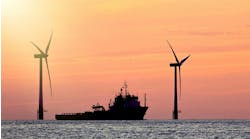Offshore industry transitions to renewables and carbon reduction strategies
Editor's note: This story first appeared in the March-April 2023 issue of Offshore magazine's Energy Transformation Strategies Special Report.
By Marie-Francoise Renard, Bureau Veritas
With high oil prices and limited regulatory obstacles encouraging continued exploration and development, the global investment portfolio for traditional oil and gas is expected to continue until at least 2050. In addition, due to natural declines in existing production sources, investment in upstream oil and natural gas will remain necessary for the next three decades. Nonetheless, low-carbon initiatives are already emerging, indicating a shift toward more sustainable practices in the industry.
Investment in upstream oil and gas versus renewables
The Energy Industries Council (EIC) database of tracked projects reveals that, for 2023, the capex funnel for upstream oil and gas projects is still twice that of renewables. However, there is a positive outlook for renewable investment, as it’s expected to exceed upstream investment by 2030, with a projected total capex of $3,263 billion compared to $2,905 billion for upstream oil and gas projects, although it is still lower than the combined midstream and upstream capex of $4,473 billion. The forecast for 2050 is that almost half of the global energy mix will be renewable. Between 2030-2050, the EIC database shows a clear trend toward renewable energy projects, with a capex of $1,438 billion, well above upstream and midstream oil and gas projects combined ($325 billion).
Renewable energy sources
Oil and gas companies are increasingly investing in renewable energy sources, such as solar power and offshore wind, which have grown exponentially in the past two years and are expected to continue. Other clean energy options are also being explored, including green and blue hydrogen, as well as carbon capture and storage (CCS) and bioenergy. However, green hydrogen production via water electrolysis is still in its infancy. Some industry experts consider blue hydrogen, produced via the steam methane reforming process, and combined with CCS strategies, to be a more viable and economic solution while the technology for green hydrogen continues to develop.
Carbon reduction technologies and strategies
Many oil and gas companies are adopting or considering various carbon reduction technologies and strategies to limit the impact of their carbon-heavy supply chains and production methods. These include electrifying assets via power from shore or from off-grid solutions like offshore wind turbines. Other carbon-reducing technologies being employed include flare optimization technology to limit or eliminate flaring, zero leak valve management, fugitive emission reduction strategies and supply chain management with regard to Scope 3 emissions. Additionally, a scheme by the International Group of Liquefied Natural Gas Importers for carbon-neutral LNG cargoes is helping to reduce emissions along their supply chains. In January 2023, Shell delivered the first carbon-neutral LNG cargo using this framework.
CCS
CCS technology is an important development that can support the offshore oil and gas industry in reducing carbon emissions from its activities. Although the announced capex for carbon capture projects ($109 billion) falls short of hydrogen projects ($120 billion), CCS is gaining momentum. For instance, the world's largest offshore CCS project is under development in Malaysia, and bp's Tangguh and Carbon Aceh projects are among 16 unveiled projects in Indonesia. Denmark also has issued permits for the exploration of CCS in the Danish North Sea, while Norway's Northern Lights CCS project is being hailed as a trailblazer.
Environmental management and sustainability strategies
The industry is increasingly taking a holistic approach to environmental management, with a focus on the entire supply chain. Bureau Veritas (BV) is supporting the oil and gas sector by offering a range of services to support their long-term sustainability strategies. For example, based on experience with the shipping industry, BV Marine & Offshore has developed rules and notations that incentivize sustainable floating units and features.
BV has experienced increased demand for Concept Approval and New Technology Qualification services, and a dedicated team has been put in place to support providing clients with the services needed to make environmentally conscious and informed decisions. New technology qualifications are proposed through a methodological approach, with a dedicated Guidance Note (NI525) as the foundation.
Methane losses from joints and flanges are a significant concern for the industry, and many oil and gas companies are increasingly engaging in methane slip detection together with a mitigation and control program development in their facilities. BV provides this service for onshore and offshore installations, as well as trading vessels, to detect and mitigate methane leaks.
The offshore oil and gas industry is shifting toward more sustainable practices through investment in renewables, carbon reduction technologies and environmental management strategies. This suggests a positive outlook for the emergence of viable solutions to reduce the industry’s carbon emissions.
About the author:
Marie-Francoise Renard is the offshore sales and marketing director with Bureau Veritas. References for this article are available upon request.





